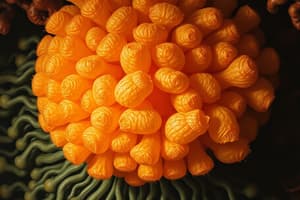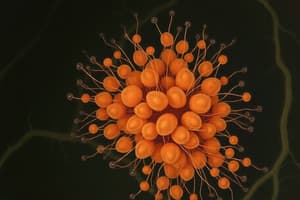Podcast
Questions and Answers
What is the main function of the Golgi apparatus in a cell?
What is the main function of the Golgi apparatus in a cell?
- Lipid synthesis
- DNA replication
- Cell division
- Protein processing and modification (correct)
Which process occurs in the Golgi apparatus to change the structure of proteins?
Which process occurs in the Golgi apparatus to change the structure of proteins?
- Photosynthesis
- DNA replication
- Mitosis
- Glycosylation (correct)
What is the primary function of the Golgi apparatus regarding proteins?
What is the primary function of the Golgi apparatus regarding proteins?
- Post-translational modification (correct)
- RNA synthesis
- Cell respiration
- Cell wall formation
Which of the following is NOT a function of the Golgi apparatus?
Which of the following is NOT a function of the Golgi apparatus?
What happens in the Golgi apparatus that is essential for proteins to perform their functions in a cell?
What happens in the Golgi apparatus that is essential for proteins to perform their functions in a cell?
In which organelle do proteins undergo post-translational modification to become fully functional?
In which organelle do proteins undergo post-translational modification to become fully functional?
What is the main function of the Golgi apparatus?
What is the main function of the Golgi apparatus?
Where are proteins and lipids assembled and modified in the Golgi apparatus?
Where are proteins and lipids assembled and modified in the Golgi apparatus?
Which organelle is responsible for the breakdown of proteins into smaller peptides or amino acids?
Which organelle is responsible for the breakdown of proteins into smaller peptides or amino acids?
What is the unique structure that characterizes the Golgi apparatus?
What is the unique structure that characterizes the Golgi apparatus?
Which function is NOT associated with the Golgi apparatus?
Which function is NOT associated with the Golgi apparatus?
What type of molecules are synthesized by the Golgi apparatus for cell recognition and signaling?
What type of molecules are synthesized by the Golgi apparatus for cell recognition and signaling?
Study Notes
Cell Biology: An Introduction
Cell biology is the branch of science concerned with understanding the structure, function, composition, and life cycle of cells. It involves studying various aspects of cell physiology, including its organelles, membranes, proteins, bioenergetics, cytoskeleton, signaling pathways, and cellular communication. In this article, we will focus on one of the crucial organelles within cell biology, the Golgi apparatus.
The Golgi Apparatus: Structure and Function
The Golgi apparatus, also known as the Golgi complex or simply Golgi, is a flattened, stacked set of sacs and tubules found in the cytoplasm of most eukaryotic cells. It plays a central role in post-translational processing of proteins, lipids, and carbohydrates, which are necessary for maintaining cellular homeostasis. The Golgi apparatus has three main functions: protein processing and modification, lipid metabolism, and the synthesis of glycoproteins and glycolipids. These tasks ensure proper functioning and maintenance of cellular processes.
Protein Processing and Modification
The Golgi apparatus is the site of post-translational modification, such as glycosylation, phosphorylation, and proteolysis, which are essential for proteins to perform their functions in the cell. Glycosylation involves the addition of sugar molecules to proteins, which can change their structure, stability, and function. Phosphorylation is the addition of a phosphate group to a protein, which can activate or inhibit its function. Proteolysis is the breakdown of proteins into smaller peptides or individual amino acids, which can be reused by the cell.
Lipid Metabolism
The Golgi apparatus is also responsible for modifying and sorting lipids, which are crucial for maintaining the structure and function of cell membranes. These lipids can be further processed and transported to the cell membrane or to the endoplasmic reticulum for further synthesis.
Synthesis of Glycoproteins and Glycolipids
The Golgi apparatus synthesizes glycoproteins, which are proteins with carbohydrate molecules attached, and glycolipids, which are lipids with carbohydrate molecules attached. These molecules are essential for cell recognition, signaling, and communication.
Golgi Apparatus: Structure and Organization
The Golgi apparatus is a highly dynamic and organized organelle with a unique structure and organization. It consists of two main parts: the cis-Golgi network (CGN) and the trans-Golgi network (TGN). The cis-Golgi network is where proteins and lipids are assembled and modified, while the trans-Golgi network is where mature vesicles are formed and transported to their final destinations.
The Golgi apparatus is also known for its unique structure, which is characterized by a series of flattened, stacked membranes called cisternae. These cisternae are arranged in a parallel fashion and are connected by vesicles and tubules that serve as transport channels between them. The Golgi apparatus is organized in such a way that proteins and lipids can be transported through it in a specific order, allowing for proper post-translational processing and modification.
Conclusion
In conclusion, the Golgi apparatus is a vital organelle in cell biology, responsible for post-translational processing and modification of proteins, lipids, and carbohydrates. Its complex structure and organization allow for efficient transportation and processing of these molecules, ensuring the proper functioning of cellular processes. Understanding the role of the Golgi apparatus in cell biology is essential for understanding the overall functioning of cells and maintaining cellular homeostasis.
Studying That Suits You
Use AI to generate personalized quizzes and flashcards to suit your learning preferences.
Description
Test your knowledge on the structure and function of the Golgi apparatus in cell biology. This quiz covers topics such as protein processing and modification, lipid metabolism, synthesis of glycoproteins and glycolipids, and the unique structure and organization of the Golgi apparatus.




